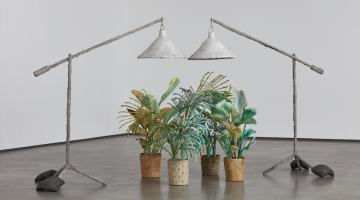Nestled on the second floor of a nondescript strip mall in Los Angeles’ Chinatown is metro pcs, a new artist run project space located on the former site of the Cambodian embassy. Protruding from the building’s façade is a tall red gate, holding you suspended against the traffic rushing up Hill Street. The sounds of rush hour are narrowly escaped by entering the gallery where the green linoleum floors are the only remnant of the space’s diplomatic history.
Nick Kramer’s solo show “The Quick Brown Fox Jumped Over the Lazy Dog And Went To Sleep Forever” is metro pcs’s third show since opening earlier this year. The press release offers a poetic narrative based around the show’s title—an adaptation of the English pangram “The Quick Brown Fox Jumped Over The Lazy Dog”. The text begins to feel like a work in itself, further creating connectivity between the sculpture’s titles, forms, and materials. Besides the titular foam sculpture, the remaining four sculptures are made from painted aluminum.
“The Part Of The Ocean Closest To The Horizon”, at first glance, looks like a cross section of a warehouse wall, five layers of concrete bricks, the porous surface texture both architectural and geological. By the connection between title and painted color, the cross-section appears to play with association between a man-made environment and a ‘natural’ environment. The teal and tan colors are given a name through this abstract association with language, suddenly ‘ocean’ and ‘horizon’ create ‘water’ and ‘land’. Yet ‘the ocean closest to the horizon’ isn’t a real place, it’s a location dependent on the location of perceiver; much like recognizing color is always relative to its perceiver. How could we know the extent to which we see the same thing? And even in this unpredictable space, somehow we still communicate.

“The Part Of The Ocean Closest To The Horizon”. Photo by Ian James. Courtesy of Metro PCS, Los Angeles.
I found myself contemplating this relation between language and materiality further in “The Deep Brown One” and “Yellow Yellow”. The two installed on opposite sides of the room still unmistakably appear like a positive and negative relationship. Like topographical or geological surface imprints, their naming complicates their understanding—”Yellow Yellow” feeling more earthy of the two in forms, yet it’s neon yellow-greenish color frighteningly not so. “The Deep Brown One” reminiscent of terracotta or clay, yet it’s form feels manipulated, planned, analyzed.
Along with “Telemer”, consisting of hanging protrusions from a wood frame that feel like carrots or fingers—all four aluminum works are riffs on forms that hold a tension between being found and being created, their forms mimicking non-aluminum materials and objects. But their names make them something different, they become contemplations on the gap between understanding how they appear, what language makes them, and what they are. Language here becomes another medium working in the space, conceptually mining and playing with our associations and perceptions of the sculptures. Much like aluminum, abundant in Earth’s core, refined for man-made purposes, their materiality as seen through the given language context drastically changes our association and perception to their forms.
A drastically different material protrudes through the length of the space. The show’s titular named foam sculpture appears as an anthropomorphized headless armless half circle with two long rectangular protrusions, slouched against the front window in a casual cross-legged position. Upon entering the space, I gravitated towards walking around the figure, taking in it’s full presence. The assumed figurative context I gave it immediately allowed me to relate and project onto it the most. It’s slouched position beckons to me, as if I could rest on it, as if it was a dear friend’s lap I could sit on and we could look at the room together. As much as it acts in a similar way to the aluminum works, both materials are malleable and stand in for other things—it’s the only material in the room that could respond to me. If touched, it would leave my impression, if only for an instant.
Through the materials, titles, press release, and colors Kramer plays a mental game of tossing ball where you become more of the ball’s movement than its recipients. And this becomes exactly the place you want to be. Slightly floating slightly grounded, change is the constant, you fall asleep and you wake back up.
This exhibition is on view through November 2nd, 2013.
For more information on “The Quick Brown Fox Jumped Over the Lazy Dog And Went To Sleep Forever” visit metro pcs, Los Angeles.
-Contributed by Merideth Hillbrand.







